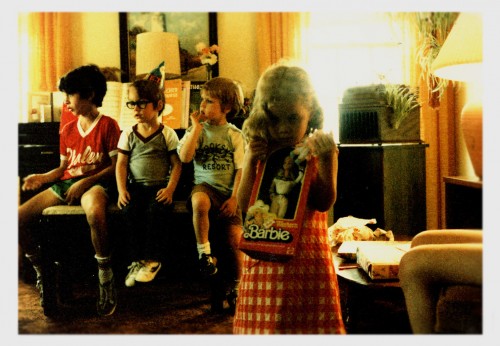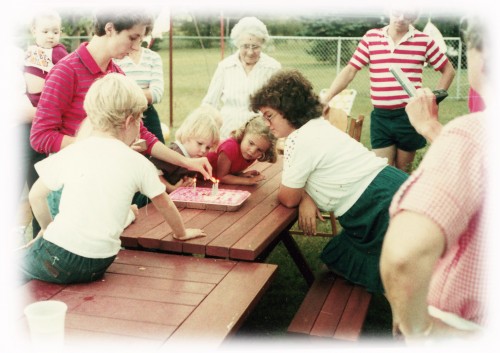People talk a lot about the decay of American cities in the 1980s. But I grew up with a profound sense of community in my blue collar, urban neighborhood. We operated a lot like the characters in the Dennis the Menace sitcom; floating in and out of each other’s houses and yards and letting our playful whims create each day’s agenda.
A game of freeze tag, followed by a Big Wheel race and 7UP popsicles kept us busy on a summer’s afternoon. On a winter’s day we might build a snow fort before noon and enjoy a couple rounds of Frogger or Candy Land after nap time. By the end of many evenings, I found myself curled up with a bunch of kids, watching whatever the three networks were showing in prime time.
Sometimes we had trouble deciding what to do; the possibilities seemed endless. A dark-haired boy named Bobby was the youngest of all of us and rarely got his way. So, he often staged protests against the tyranny of our preference for Chutes and Ladders over Operation or t-ball over dodge ball. He’d declare that he was going home and threaten us with punishment once his dad heard about our dictatorship. Ten minutes later, he’d walk back into the yard with his preschool-aged chest puffed up, bearing an edict from his father that we were to immediately stop what we were doing and follow his game plan.
At first we heeded the commands from on high. But, one day Bobby’s older brother, Patrick, got the idea to spy on him. Shortly after Bobby left my basement playroom, Patrick and I bolted up the stairs and straight out the back door. We rounded the corner of the house on tiptoes and squinted to see the action six houses down. Instead of watching Bobby ascend the stairs into his own home, we found him sitting alone on the edge of his yard. After several minutes – enough time for the fear of his father to build in our imaginations – he stood up and sauntered back to my house.
This was Bobby’s response to being left out.
My current work as a video producer offers me ample opportunity to study community. I get to tell stories of men, women, children and teens who work to bring people together. The job recently brought me to Flagstaff, Ariz., where I met a seven-year-old girl engaged in community building on an entirely different level than I could have imagined in the heyday of my childhood social life.
This second grader rides bikes, plays tag and puts on puppet shows with her friends and sister. But, once a month, she invites everyone she knows to a prayer party – an event she’s been hosting since she was a kindergartener. Her guest list includes peers from her Baha’i community and her gymnastics class, as well as her parents’ friends and their kids.
They all convene around a fire pit in her backyard and share the promptings of their hearts. They recite prayers, offer favorite quotes from scripture and sing songs. The day I visited, the prayer party hostess started a round of “This Little Light of Mine.” Most of the kids wanted to share their light with neighbors, siblings and people they knew at school. But, a four-year-old wanted to share hers with unicorns and everyone else complied, singing “This little light of mine, I want to share it with the unicorns.” Giggling ensued.
When I asked the seven-year-old hostess how she defines the word community, she said “It means no one is left out.”
I think this definition is pretty solid. The ideal community embraces everyone. It gets to know each individual. It discovers the gifts and talents everyone has to share and allows those to be contributed to the common good. But, of course, community isn’t a
disembodied “‘it.” Community is composed of individuals, all of whom crave to belong.
As a kid, I believed maturity would lead to fewer instances of exclusion. In fifth grade, when I saw the cool kids with the skater haircuts and British Knights shoes create their own gated communities in the schoolyard, I told myself that karma would put them in their place. When they swam in the larger pond of high school, someone would cast them out too and that experience would soften them.
But, it seems instead that inclusive behavior becomes more difficult the older we get. We all want to fit in and since our generation favors snarkiness, we gain popularity when we find clever ways to insult one another.
It seems to me that building community requires a little sacrifice. The process asks us to give up the comfort of widespread popularity and seek, instead, to connect with those who are left out. Sometimes, counterintuitively, community building means feeling a little lonely. It might mean standing apart and saying no to any exclusive tendencies of the crowd. Maybe it means having lunch with the underdog at work or forgoing the loud banter at a party for a one-on-one conversation with the person sitting alone. I can only hope that the ultimate reward for this sacrifice is the satisfaction of seeing greater peace in our own little spheres of influence.


This is wonderful. Thanks for sharing, Kari.
First of all, kudos for including the photos from your childhood. They illustrate beautifully communities of neighborhood and generations.
Secondly, I truly believe that we change the world one heart at a time. Your article powerfully supports that. Thank you!